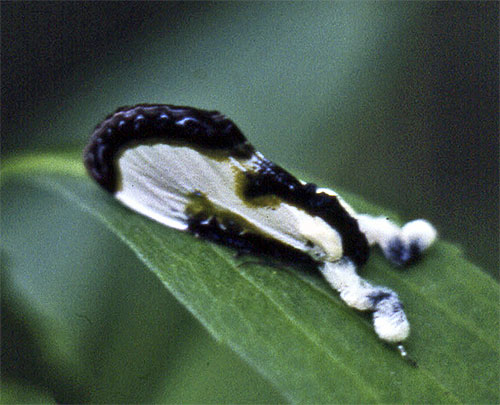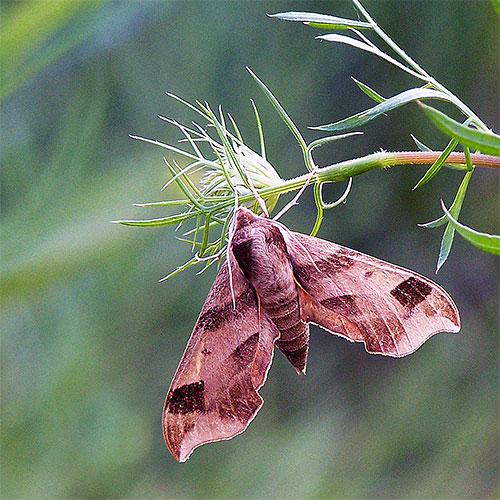Greetings, BugFans,
Moths (and butterflies too) are in the order Lepidoptera (from the Greek lepis—scale and pteron—wing). A Lepidopteran’s color is in the scales that cover its wings, legs and bodies, and these scales brush off easily when the insects are handled. Though butterflies are flashier than moths, moths outnumber them pretty dramatically. Of the 12,000+ species of Lepidoptera in North America north of Mexico, only about 700 are butterflies. This episode features two very different moths that share the same food plant, a vine in the grape family called Virginia Creeper.
Beautiful Wood Nymph
The first of these Creeper-eaters, is the (probably) Beautiful Wood Nymph (Eudryas grata), a magnificent member of the Owlet Moth family, Noctuidae, which is the largest family in the Lepidoptera. Eurydice, as you recall from your high school unit on Mythology was an oak nymph. Beautiful Wood Nymphs (BWNs) have a wingspread of almost 2.” They can be found throughout eastern North America at forest edges, where the larval food plants grow.
BWNs are, spectacularly, bird poop mimics. The BugLady knew this slide wasn’t super when she scanned it—it was taken in very low light with a flash-less camera—but you can still see what a spiffy moth it is! Its wings are somewhat rolled, which disguises its moth-y shape, and its long, elegant front legs purport to be runnier bits of bird poop that have dribbled down the leaf.
It is the caterpillar that pillages Virginia Creepers; the adult (moth) doesn’t eat at all and isn’t around for long. Caterpillars eat the leaves of buttonbush, wild hops, grapes, Virginia creeper, and pepper vine. Where the adult’s defense is passive, the caterpillar’s is active. Startle a BWN caterpillar and it will tuck in the caterpillar equivalent of its chin and elevate the front part of its body in a traditional “caterpillar salute.”
Virginia Creeper Sphinx
The Virginia Creeper Sphinx (Darapsa myron), also called the Grapevine Sphinx, the Myron Sphinx, and the Hog Sphinx, is found from Nova Scotia to Manitoba to New Mexico to Florida and on down into Mexico. The BugLady gets the first two names—they are caterpillar food plants. She hasn’t been able to find out who Myron was (the species was named in 1779, so Myron is long gone) and she doesn’t know what the association with hogs is.
Adults sip nectar from a variety of flowers. The nocturnal Ms. VCS attracts the nocturnal Mr. VCS via pheromones—airborne scents.
Like typical members of the Sphinx family (Sphingidae), VCS caterpillars have a curved horn on their posterior. The caterpillars are well-camouflaged on the leaves of their food plants. Several references mention how interesting it is to watch its first meal traveling through the gut of a temporarily translucent, newly-hatched larva. Get your fun where you can, says the BugLady. The leaves whose journeys you may observe come from viburnum, grape or Virginia creeper. Before it settles down to several weeks of grazing on leaves, though, a VCS larva eats its own egg. When stinkbug nymphs do the same thing, they pick up bacteria from their Mom’s gut which helps them to digest the cellulose in their food; the BugLady assumes that the same thing is going on here.
When disturbed, these larvae also resort to the “caterpillar salute,” accompanied by a thrashing back and forth of their front end in the air that makes a crackling sound. “Sphinx” moths are purportedly named for the “sphinx-like” alarm position of the caterpillars.
VCSs are plagued by parasitic Ichneumon wasps that lay their eggs (plural) on a caterpillar. When the wasp larvae emerge, they burrow into the caterpillar and eat fatty tissue under the surface. The wasp larvae pupate in little silken cases they spin on the caterpillar’s outside. According to Frost, in Insect Life and Natural History, “Caterpillars which have been thus parasitized do not survive the ordeal.”
The BugLady

